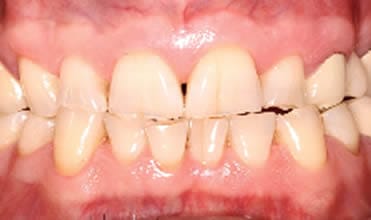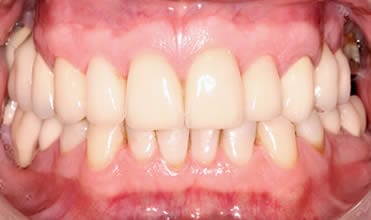Treatment of excessively worn teeth
What is Tooth Surface Loss?

Tooth Surface Loss (or ‘TSL’) is the wearing away of the surfaces of the teeth. It is a process that happens throughout life due to normal wear and tear(Physiological TSL). However, we sometimes see teeth wearing at an accelerated rate, over and above what we would expect from normal use. This is called Pathological TSL and it is a major cause of tooth sensitivity and tooth fracture. Physiological TSL requires no treatment, Pathological TSL will require intervention to preserve the structural integrity of the teeth.
What causes Pathological TSL
Excessive tooth wear is believed to be caused by a combination of factors. These are:
Erosion - this is the loss of surface tooth tissue by the action of acidic substances. The acids soften the tooth surface which is then worn away easily by normal chewing and cleaning. Acids are mostly found in the diet and examples include alcohol, fruit juices, and fizzy drinks. Consumption of these agents in excessive amounts will erode the enamel off the teeth with time. Acid attack on the teeth can also be caused by the stomach acid reflux associated with some conditions such as Hiatus Hernia. It is thought that acidic vapor from the stomach escapes up into the mouth where it can attack the surfaces of the teeth.
Eating disorders such as Anorexia and Bulemia expose the teeth to the very strong stomach acids on a regular basis usually resulting in severe erosion of the tooth enamel.
Abrasion - This is the wearing away of the tooth surface by some external influence. It is most commonly caused by an incorrect tooth-brushing technique which wears away enamel typically at the necks of the teeth. Many patients will be aware of slight grooves in the necks of some teeth which are sensitive to temperature changes - this is a sign of toothbrush abrasion. Habits such as nail-biting and pen-chewing cause abrasion of the edges of the front teeth, often resulting in chipping of the enamel and a jagged-edge appearance of the teeth.
Attrition - This is wear caused by the action of the teeth grinding against each other. A normal amount of attrition caused by chewing food is expected with time. Some habits such as grinding and clenching (‘Bruxism’) result in an increased rate of wear on the teeth. It is believed that the forces applied to the teeth during grinding are twenty times those applied during normal chewing and this has a significant effect on the rate of wear of the teeth. Bruxism is a very common habit; it typically occurs at night while we are asleep and many patients will be completely unaware that they grind.
Pathological wear will typically be caused by a combination of all the above, but with a predominance of one factor. For example, a patient with a high fizzy drink or alcohol intake habit will erode their teeth. The remaining tooth surfaces will be weakened as a result. An incorrect tooth-brushing technique will then wear away the weakened tooth structure very quickly.
It is worth noting that the combination of a high dietary acid intake (usually in the form of frequent fizzy drinks) and a grinding habit is particularly destructive to the teeth, often resulting in severe wear.
What are the signs and symptoms of Pathological TSL?
Excessive tooth wear may result in some or all of the following:
- A worn look to the teeth with a serrated edge appearance to the incisors and pitting of the chewing surfaces of the molars
- Sensitivity to hot & cold, and/or chewing
- Repeated tooth/restoration fracture
How can I prevent my teeth wearing excessively?
As with any other condition prevention is better than cure. Following a few simple rules will ensure your teeth will remain solid and strong for your lifetime
- Avoid excess dietary acid intake - minimal fizzy drinks and no more than 1 glass of fruit juice per day. Taking acidic drinks through a straw helps to keep the acid away from the teeth.
- Make sure any gastric reflux conditions are properly managed to avoid gastric acid or gases entering the mouth
- Use a correct toothbrushing technique as demonstrated by your Dentist/Hygienist
- Avoid nail-biting, pen-chewing, and using your teeth to tear tape or open packets
- Tell your dentist if you think you may be grinding/clenching your teeth out of habit
- Visit your Dentist regularly for monitoring and advice. Your dentist routinely monitors your teeth for signs of excess wear. They will question you on your dietary acid intake, any habits you have such as nail-biting, and your tooth-brushing technique. This will allow them to properly assess your risk for pathological TSL. Visiting your dentist regularly will enable them to spot the signs of excess wear long before you are aware of it.
How is Pathological TSL treated?
Your Dentist will first identify the risk factors and causes of your excessive tooth wear and will then advise you on what you need to do to eliminate them. This may include:
- Dietary advice - how to avoid acid coming into contact with your teeth
- Correct tooth-brushing technique demonstration
- Highlighting of destructive habits
- Provision of a bite guard if a night-time grinding habit is suspected.
If the wear is minor, you may require nothing more than regular (six-monthly) monitoring to make sure your risk factors remain low and your wear does not progress.
If the wear is moderate or severe, you may need treatment of the worn teeth/restorations not only to restore the damage already done, but to strengthen and protect the teeth from any future excess wear. Your dentist will advise you on the types of restoration available, their costs, and the risks versus benefits of each.
 Before treatment
Before treatment After treatment
After treatment

